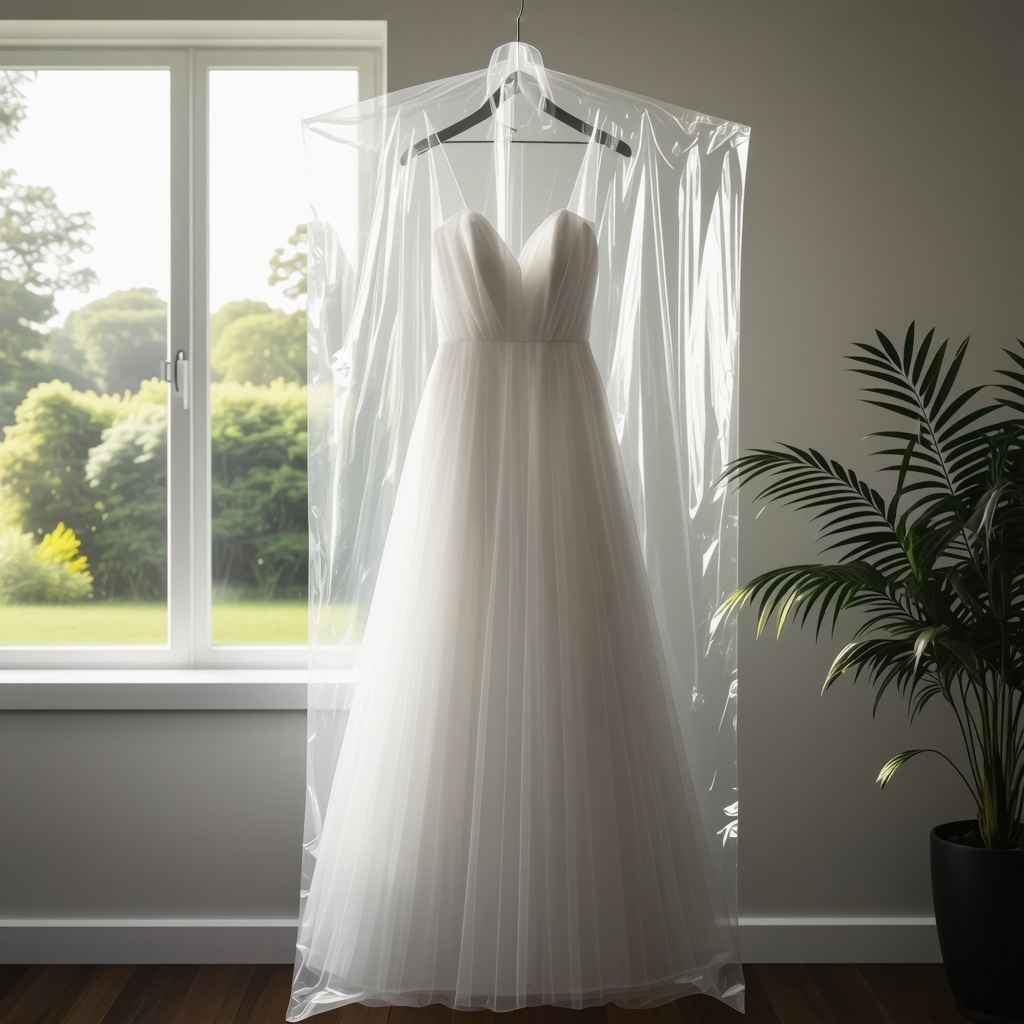Understanding the Nuances of Wedding Gown Preservation in the Wiregrass Area
Wedding gown preservation is an intricate discipline that transcends mere cleaning; it involves a comprehensive approach to maintain fabric integrity, color fidelity, and structural form over time. Brides in the Wiregrass Area face unique environmental challenges—including humidity and pollen exposure—that can accelerate fabric degradation. Therefore, adopting preservation methods tailored to local conditions is essential for safeguarding these priceless heirlooms.
Advanced Techniques for Fabric Protection and Long-Term Storage
Preserving a wedding gown requires meticulous attention to fabric types such as silk, satin, lace, and tulle, each demanding specific care protocols. Professional dry cleaning using solvent systems designed for delicate textiles remains the gold standard, effectively removing organic stains without compromising the gown’s fibers. Post-cleaning, acid-free tissue paper interleaving prevents creasing and color migration, while storage in breathable, archival-quality boxes mitigates risks from light and moisture exposure.
How Do Environmental Factors in the Wiregrass Area Affect Wedding Gown Longevity?
The Wiregrass Area’s subtropical climate introduces elevated humidity levels that foster mold and mildew formation on improperly stored gowns. Moreover, airborne particulates such as grass pollen and dust can embed into fabric weaves, causing discoloration. Implementing climate-controlled storage solutions with humidity regulation and air filtration significantly extends the lifespan and visual purity of wedding gowns. Utilizing desiccants and routinely inspecting the garment for early signs of deterioration are proactive steps recommended by textile conservation experts.
Specialized Stain Removal and Preservation Strategies for Local Brides
Post-ceremony stains from grass, wine, and perspiration are common concerns requiring immediate and expert intervention. Employing enzymatic stain removers tailored to protein-based and tannin stains enhances removal efficacy without damaging delicate embroidery or beadwork. Brides are advised to seek out local specialists who understand the specific stain profiles prevalent in the Wiregrass Area, as outlined in expert stain removal guides. This precision in stain treatment ensures preservation of original fabric texture and hue.
Integrating Sustainable Practices into Wedding Gown Care
Emerging trends in bridal gown preservation emphasize eco-friendly cleaning solvents and biodegradable storage materials, aligning with broader environmental stewardship goals. Wiregrass brides seeking sustainable options can explore services that utilize green chemistry techniques and non-toxic preservation materials, thereby reducing chemical residues and environmental impact while maintaining premium gown care standards. This approach not only preserves the gown but also supports health-conscious and ecological commitments.
Explore More Expert-Level Bridal Care Insights
For further in-depth strategies on bridal gown preservation, including museum-quality techniques specifically adapted for Tampa Bay area brides, visit our comprehensive resource here. We also invite professionals and experienced brides to contribute their insights to enrich this evolving field.
According to textile conservation research published by the Journal of Textile Conservation Science, environmental control and tailored chemical treatments are critical determinants of long-term fabric preservation success.
Innovative Climate-Controlled Storage Solutions for Wedding Gowns
Given the Wiregrass Area’s distinct climatic challenges, sophisticated storage solutions are indispensable for wedding gown longevity. Beyond traditional acid-free boxes, climate-controlled units that maintain stable temperature and humidity can drastically reduce the risk of fabric degradation. Incorporating silica gel packets or natural desiccants within storage further optimizes moisture absorption, providing an extra layer of defense against mildew and mold. Selecting storage spaces away from direct sunlight and fluctuating temperatures also plays a pivotal role in preserving the delicate textures and colors of gowns.
Cutting-Edge Fabric Analysis for Tailored Preservation Protocols
Modern textile conservation has embraced advanced spectroscopic and microscopic analysis to identify fabric composition and damage extent with unprecedented precision. Such diagnostics enable preservationists to customize cleaning solvents and storage conditions, minimizing adverse reactions and prolonging fabric integrity. For instance, identifying silk fibroin degradation early allows for immediate intervention using specialized stabilizers. Wiregrass brides can benefit from experts who leverage these technologies, ensuring their gowns receive preservation care optimized specifically for their material and environmental exposure.
What Are the Latest Technological Advances Enhancing Wedding Dress Preservation in Humid Regions?
Recent innovations include the application of nanotechnology-based protective coatings that provide water-repellent and anti-microbial barriers without altering fabric breathability. Additionally, controlled atmosphere storage using inert gases like nitrogen can suppress oxidative damage over extended periods. These advances, combined with continuous environmental monitoring via smart sensors, empower preservationists to maintain gowns in near-museum-quality condition despite regional humidity. Such cutting-edge methods are increasingly accessible through specialized bridal gown preservation services in the Tampa Bay and Wiregrass regions.
Expert Collaboration and Community Knowledge Sharing
Engagement between textile scientists, professional cleaners, and bridal communities fosters a knowledge ecosystem that drives continual improvements in wedding gown care. Platforms inviting expert contributions and bride testimonials enrich understanding of local challenges and solutions, catalyzing innovation. Interested readers and professionals are encouraged to share their experiences and insights to support this collaborative advancement. Explore more about sophisticated preservation techniques and community discussions on our dedicated expert wedding dress cleaning services page.
According to the comprehensive review in the International Journal of Conservation Science, integrating nanotechnology and environmental controls represents a transformative step in fabric preservation science, particularly for textiles vulnerable to humid climates.
We invite readers to comment below with their preservation questions or experiences, and share this article with fellow brides and textile enthusiasts to elevate community knowledge on sustainable and effective wedding gown care.
Revolutionizing Wedding Gown Preservation: The Role of Artificial Intelligence and Smart Textiles in the Wiregrass Area
As technology permeates every facet of textile care, the wedding gown preservation industry is undergoing a profound transformation. In the Wiregrass Area, where environmental stressors challenge traditional preservation methods, integrating artificial intelligence (AI) with smart textile technologies offers unprecedented precision and adaptability. AI-driven monitoring systems can analyze microclimatic conditions surrounding the gown in real time, adjusting humidity and temperature controls dynamically to prevent fabric degradation. Moreover, smart textiles embedded with micro-sensors facilitate early detection of stress points or discoloration, alerting conservationists before irreparable damage occurs.
This synergy between AI and responsive textiles not only enhances protection but also personalizes preservation protocols according to the unique material composition and environmental exposure of each gown. Such advancements promise a new paradigm where preservation transcends static storage, evolving into an interactive, intelligent process tailored for the nuanced demands of the Wiregrass climate.
How Does AI-Driven Environmental Control Specifically Mitigate Mold and Mildew Risks in High-Humidity Bridal Gown Storage?
AI-enabled environmental control systems employ predictive analytics to anticipate periods of elevated humidity and temperature fluctuations common in the Wiregrass Area. By processing sensor data on ambient moisture and temperature trends, the system preemptively activates dehumidifiers or adjusts airflow to maintain optimal storage conditions. This proactive approach mitigates mold and mildew proliferation by consistently sustaining relative humidity levels below 50%, a critical threshold identified by the Environmental Microbiology Reports. Furthermore, AI algorithms learn from historical data to refine operational parameters, reducing energy consumption while maximizing fabric protection. This represents a significant leap from reactive preservation tactics to anticipatory, data-driven stewardship of delicate bridal textiles.
Smart Textiles: Embedding Intelligence into Wedding Gown Fibers for Proactive Preservation
Beyond environmental control, smart textiles embedded within wedding gowns are pioneering a shift towards intrinsic preservation. These textiles incorporate nano-scale sensors capable of detecting alterations in pH, moisture content, and even mechanical strain on fibers. Early identification of such stressors enables timely interventions, such as localized treatment or adjustments in storage conditions, preventing progressive deterioration.
For Wiregrass brides, this means their gowns can self-report vulnerabilities related to local environmental challenges like pollen adhesion or sudden humidity spikes. Research from the Journal of Nano Energy highlights the potential of energy-harvesting smart fabrics that power these sensors sustainably, eliminating the need for external batteries and enhancing long-term monitoring feasibility.

Analyzing the Intersection of Nanotechnology and Textile Preservation: Implications for Future Bridal Gown Care
Nanotechnology continues to push the boundaries of textile conservation by introducing protective coatings that are both invisible and breathable. These nano-coatings create hydrophobic and antimicrobial layers that shield the gown from moisture ingress and microbial colonization without compromising fabric hand or appearance. In humid environments like the Wiregrass Area, such coatings drastically reduce the risk of mold, mildew, and staining from airborne pollutants.
Integrating nanotechnology with AI and smart textile systems results in a holistic preservation ecosystem. These multifaceted approaches address the molecular, environmental, and operational variables affecting wedding gown longevity, offering an unprecedented level of protection.1
Invitation to Engage: Share Your Expertise and Embrace Cutting-Edge Bridal Gown Preservation
We encourage textile conservators, bridal professionals, and brides in the Wiregrass Area to engage with these emerging technologies and share experiential insights. By fostering a collaborative network, we can accelerate the adoption of intelligent preservation practices that honor both tradition and innovation. For those seeking specialized AI-integrated preservation services, explore our curated directory of expert providers who pioneer these advancements.
Stay connected and deepen your expertise by subscribing to our newsletter, where we regularly feature breakthroughs in textile conservation science and hands-on guidance tailored for humid climate bridal care.
1 For comprehensive insights on nanotechnology applications in textile preservation, consult the International Journal of Conservation Science.
Synergizing AI Algorithms with Textile Science for Optimal Gown Longevity
As the Wiregrass Area’s unique environmental conditions challenge traditional bridal gown preservation, the integration of artificial intelligence (AI) has emerged as a transformative solution. AI-powered systems now enable real-time monitoring and adaptive control of storage environments, dynamically adjusting humidity and temperature to preempt fabric deterioration. These systems utilize complex predictive models trained on microclimate data, ensuring gowns remain in pristine condition despite fluctuating local weather patterns.
Nanotechnological Innovations: Invisible Armor for Delicate Bridal Fabrics
Recent breakthroughs in nanotechnology introduce ultra-thin, breathable coatings that confer hydrophobicity and microbial resistance without altering tactile qualities. These nano-coatings form a molecular barrier, significantly reducing moisture absorption and inhibiting microbial colonization — a critical advancement for combating the Wiregrass Area’s high humidity and airborne spores. The coatings are engineered to maintain fabric breathability, preserving both comfort and appearance over decades.
How Do AI-Enabled Smart Storage Systems Integrate with Nanocoatings to Enhance Fabric Preservation?
AI-enabled smart storage environments synergize with nanocoated gowns by continuously analyzing sensor data from embedded micro-sensors within the fabric. This bidirectional communication allows for immediate environmental adjustments when sensors detect early-stage stressors such as increased moisture or pH shifts indicative of microbial activity. Consequently, AI systems can activate dehumidifiers or ventilation proactively, optimizing conditions to extend fabric integrity. This integration exemplifies a holistic preservation strategy, marrying molecular protection with environmental intelligence for unparalleled gown care.
Expert-Recommended Protocols for Implementing Advanced Preservation Technologies
Textile conservation specialists recommend a phased approach: initially, precise fabric composition analysis using spectroscopy informs the selection of compatible nanocoatings. Subsequently, embedding passive micro-sensors into gown fibers facilitates continuous condition monitoring without compromising aesthetics. Finally, housing gowns in AI-managed climate-controlled units with data logging capabilities completes the preservation ecosystem. This protocol not only mitigates common degradation pathways but also generates valuable longitudinal data for ongoing care optimization.
Engage with Pioneers in Textile Preservation and Transform Your Bridal Gown Care
For Wiregrass brides and preservation professionals eager to adopt these cutting-edge methodologies, we invite you to explore our curated network of specialists proficient in AI and nanotechnology applications. Staying informed through authoritative sources such as the International Journal of Conservation Science ensures access to the latest empirical research underpinning these innovations.
Embrace the future of wedding gown preservation—connect with our expert community, share your experiences, and elevate your gown care strategy to unparalleled heights.
Expert Insights & Advanced Considerations
Adaptive Preservation Strategies Tailored to Regional Climate Variability
Recognizing the fluctuating humidity and temperature patterns in the Wiregrass Area is paramount. Preservation protocols must be dynamic, incorporating environmental sensors and responsive controls rather than relying solely on static storage solutions. Such adaptability ensures that gowns remain protected against episodic moisture surges and temperature spikes that can accelerate fiber degradation.
Synergistic Application of Nanotechnology and Smart Textiles for Molecular-Level Defense
The integration of nanocoatings with embedded micro-sensors within gown fabrics represents a frontier in textile conservation. This dual approach not only forms a breathable barrier against microbial invasion and moisture ingress but also enables real-time condition monitoring. This synergy allows for preemptive interventions that maintain fabric integrity at a molecular scale.
Phased Implementation of AI-Driven Environmental Controls for Optimal Fabric Longevity
Experts advocate a phased adoption of AI-enabled climate management systems, beginning with precise fabric diagnostics followed by embedding passive sensors and culminating in deployment of intelligent storage units. This structured methodology minimizes preservation risks while generating valuable data sets that inform ongoing care optimization and research.
Collaborative Knowledge Sharing Among Textile Scientists and Bridal Professionals
Fostering an engaged community that includes conservators, bridal service providers, and informed brides accelerates innovation. By sharing case studies, empirical data, and regional insights, stakeholders enhance collective understanding and refine preservation techniques tailored to the Wiregrass Area’s unique challenges.
Curated Expert Resources
International Journal of Conservation Science: A leading publication offering comprehensive research on nanotechnology applications and environmental control methods in textile preservation, essential for understanding state-of-the-art bridal gown care.
Journal of Textile Conservation Science: Provides in-depth studies on fabric degradation mechanisms and tailored chemical treatments that inform expert cleaning and storage strategies.
Environmental Microbiology Reports: Offers critical insights into mold and mildew proliferation control relevant to humid climate gown preservation.
Journal of Nano Energy: Explores innovations in smart textiles, including energy-harvesting sensors that facilitate sustainable garment monitoring.
Wedding Dress Cleaning Tampa Expert Services: A curated directory and knowledge hub for local professionals specializing in advanced preservation techniques integrating AI and nanotechnology (Explore Services).
Final Expert Perspective
In the context of the Wiregrass Area, wedding gown preservation transcends conventional cleaning and storage; it demands an intelligent, multifaceted approach that embraces technological innovation and environmental responsiveness. The convergence of AI-driven climate control, nanotechnological fabric protection, and embedded smart sensors establishes a new paradigm for extending gown longevity with unprecedented precision. Stakeholders who engage deeply with these advancements and contribute to collaborative knowledge networks will lead the evolution of bridal gown conservation. For brides and professionals eager to elevate their preservation practices, exploring specialized resources like Bridal Gown Preservation Secrets for Tampa Weddings offers valuable insights and proven methodologies. Join the discourse, share your expertise, and secure your gown’s legacy through informed, cutting-edge care.

